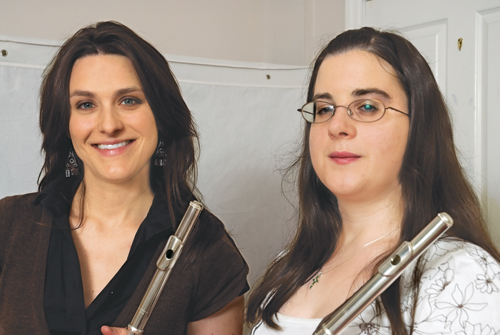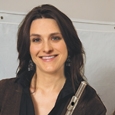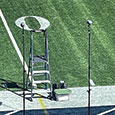
Although there are many aspects to flute teaching, tone production is the most fundamental; it is the foundation for everything we do on the instrument. Based on my experience teaching a deaf flute student, Alison Stephenson, I have explored how hearing in the traditional sense is not essential when teaching tone to deaf students.1
Alison Stephenson is a 24-year-old deaf flutist living in Yorkshire, England. While she prepares the Muczynski Sonata for a future recital, she works as a free-lance flutist in the area. In her spare time she volunteers for England’s cutting-edge Music and the Deaf organization, works with the The National Deaf Children’s Society, and speaks about deaf awareness at academic institutions around the U.K.
Developing a homogeneous sound is sought by all advanced flutists, and this includes my student Alison Stephenson. By homogeneous sound I mean the ability to play the flute with a singing tone on all notes. Trevor Wye explains that “to play one note with a good tone is not too difficult and requires the right combination of air speed, air direction, and lip position in relation to the embouchure hole. But when moving to a new note, it requires the need to change to new values necessary to produce the second note with an equally good tone”.6
When working with hearing pupils, tone homogeneity can be heard and then corrected using various studies such as Wye’s approach and the 1934 classic De La Senorite by Marcel Moyse. With a deaf pupil, however, developing a homogeneous tone is not as clear cut as just assigning these classic studies.
Sound production is not just the result of the tone made from inside the instrument but is a complex combination of the player and the flute. America’s avant-garde flutist Robert Dick says that “the sound we hear is that of the air vibrating within the flute, but resonated from inside the flutist.”7
Stephenson has discovered how to recognize when her tone is not homogeneous because she is not feeling the usual reverberations (or resonance) in her body evenly on all the notes. Similar to training deaf children to differentiate vibrations to achieve tone discrimination, she explains that her way of hearing a homogeneous tone is through feeling her flute tone vibrating in her body. Like most flutists, she feels reverberation in her throat, chest cavity, head, stomach, arms, and legs. What sets her apart, however, is that she has learned to clearly distinguish the tiny differences that are felt on each tone she produces. When the usual sensation of an even sound is not there, she knows what she should fix to even the tone production when moving from one note to another.
In a more detailed body mapping of her tone production, Stephenson often tells me that it is important for her to establish where certain tones are felt in her body in order to memorize where she should direct the air stream. For example, she feels low notes mainly in her right hand, arm, and chest. If that does not happen, she knows that her tone is suffering and adjusts the air stream into the parts of her body that are associated with that tone.
She has developed acute sensitivity to the sensations experienced in her lips to hone in on inaccuracies. She has created a highly detailed approach to recognizing these reverberations and as a result is able to control her tone. Because she uses the sense of resonance from within herself to know she is producing a sound, she has a beautiful full tone that rings with overtones and reverberations.
Ruth Montgomery, a prominent spokesperson for deaf musicians and herself a professional deaf flutist, says that “deaf people rely on the physical feelings they experience, which can take a little more time to self monitor than relying on accurate hearing.” To understand how the body should feel to produce a flute technique is a lot more challenging than hearing a sound and mimicking it.8
Deaf flutists memorize the jaw and lip muscle placement that is involved when recreating the desired technique. An example would be the difference between mimicking a foreign accent after hearing it, or copying it by trying to feel the way certain muscles move in the mouth to mirror the lilts associated with its speech patterns.
To help Stephenson develop her awareness of exact lip placement in tone production even further, I assigned Trevor Wye’s harmonic study from his Tone Book.6 According to Robert Dick, one purpose of harmonic studies is to increase the strength of the lips and to develop the best embouchure position required to produce a sonorous tone on each pitch,4 which is what I was hoping she would discover. The Trevor Wye harmonic study starts on low C and then over-blows to the various natural harmonics (C, E, G, C, etc).
At her next lesson, she glided along the study, popping out harmonics without the usual hesitation that other students often experience. She had fully memorized the lip and jaw placement to recreate harmonics at any given interval without ever hearing them. While she can’t hear tone quality in the same manner as a hearing person, she can feel it. Her ability to memorize muscle placement is already at a high standard. She demonstrates that even if a flutist cannot clearly hear, she can achieve a fabulous, rich tone through feeling the position required to recreate an interval.
Articulation
Visual images and colorful verbal descriptions are often the best ways of teaching articulation styles to her. For a hearing pupil, one play is often enough to illustrate a staccato note so they can emulate a short sound with bounce. For a deaf person it is more helpful to use a visual image to describe what a short note would look and feel like.
As Stephenson had never heard a short bouncy note, I decided to set the stage with a story to create the lighthearted nature of the opening Ds in the first two measures of the Rondo movement of Mozart’s Concerto in G Major. The description went something like this:
On a sunny day a little girl with blond pigtails was joyously bouncing down the street on a space hopper. Her pigtails were also bouncing in rhythm to her jumps, and she was so happy to be outside on such a beautiful spring day. In fact, she was so happy that each bounce got higher and faster with anticipation to her destination, the ice cream truck waiting for her at the end the road.
After we laughed at the description, she understood what an image of bouncy staccato might look like. Her playing of the phrase was then infused with lightheartedness and staccatos.
Tone Projection
When Stephenson plays with an intention of tone projection, the effect is clear in her playing. Nancy Toff suggests that a gorgeous, focused, intense sound is an “intuitive and psychological phenomenon as much as a physical one.”9 If she intends to play a phrase infused with warm sounds, it usually comes across that way.
Georges Barrere, the legendary flutist, suggested that players should visualize setting “the air around themselves into vibration.”9 Barrere suggested that using psychological images will aid the flutist in an intention of a focused tone.
If sound is measured in decibels, then what is considered loud to some is not to others, depending on one’s hearing capacity. According to Daniel Levitin, author of Your Brain On Music, “Loudness is a purely psychological phenomenon, that is, loudness does not exist in the world, it only exists in our mind. When you are adjusting the output to your stereo system, you’re technically increasing the amplitude of the vibration of molecules, which in turn is interpreted by loudness in our brains.”10 The idea that loudness and projection are linked with vibrations in the air helps Stephenson feel a projected sound. She tells me that the concept of a forte tone means little to her except that she uses more air to focus the tone.
When working with deaf children, music therapist Rita Keiner discovered that some pupils developed a great antipathy to certain music that had nothing to do with whether they could hear it. “There seems to be an innate inner response and capacity for music that transcends even severe deafness.”11
Communication
At our first lesson together Stephenson assured me that she could read lips and that she would bring along some British Sign Language Basics for me to study. We also use whatever we can to communicate, including writing unfamiliar music words and drawing pictures to describe ideas. Communication in flute lessons has played the most important role in discovering a tone based on feeling alone.
Alison and I are in our second year together and are both learning new ways of communicating what it means to “hear” sound. Our lessons have helped us develop new ways of exploring an interpretation based on feeling alone. I am often asked how I teach a deaf student and what role does she have in music. What Davis Ely Bartlett wrote in 1848 still holds true today:
In estimating the pleasure that is derived from music, it must not be forgotten that the sensation or perception of sound is not the whole of the pleasure to be produced by music. If the question be raised, what possible reason can be learned from teaching music to the deaf?… It may be answered: What benefit is ever raised from teaching music? It is a means of intellectual cultivation.”12
Musicians try to develop an impeccable ear so that they can hear and fix inaccuracies in their playing.6 The discoveries I made working with Stephenson suggest that tone production is not only about hearing inaccuracies in playing but about feeling them as well. As my lessons with Alison suggest, the stories and experiences of deaf musicians are an important tool for understanding the many layers of music. A heightened awareness of how notes feel as well as how they sound, might help hearing flutists improve their tone as well.
I would encourage flute teachers to work with a deaf student if they get the opportunity. Using traditional methods, with some modifications plus understanding, confidence, and preparation, will lead to a successful experience for both teacher and student.
Deaf Musicians and Sound
Music is included in most educational programs for the deaf throughout the world.2 Yet in spite of numerous studies about the benefits of music education for the deaf, it still surprises many people.3 Questions frequently arise such as, “How do deaf people play music?” and “How would a deaf person make music if they could not hear it?”
There are fine examples of deaf musicians today, who enjoy successful music careers and have risen to the top of their profession – Dame Evelyn Glennie, a world-renowned percussionist and Janine Roebuck, a professional mezzo-soprano, are just two examples. They have overcome prejudices and challenged beliefs of what it means to experience sound.
Just as the senses of taste and smell are closely related, science shows that a close connection exists between the sense of hearing and the sense of touch. The ear is designed to respond to a solid block of sound as well as vibrations in the air.2 This explains why, when we go to a rock concert, the body feels the pulses of the sound, even with earplugs to block the noise.
Because hearing is the combination of touch and sound, you can argue that hearing in the most recognized form (sound only resulting from what enters our ear) is not the only way to hear. From a pedagogical standpoint, it means that hearing in the traditional sense is not essential to learn an instrument.
Evelyn Glennie argues that no one person on this planet, hearing or deaf, experiences sounds in the same way. She writes:
There is a common misconception that deaf people live in a world of silence. To understand the nature of deafness, first one has to understand the nature of hearing.
Hearing is basically a specialized form of touch. Sound is simply vibrating air which the ear picks up and converts to electrical signals, which are then interpreted by the brain. The sense of hearing is not the only sense that can do this, touch can do this too. If you are standing by the road and a large truck goes by, do you hear or feel the vibration? The answer is both. With very low frequency vibration the ear starts becoming inefficient, and the rest of the body’s sense of touch starts to take over. For some reason we tend to make a distinction between hearing a sound and feeling a vibration, in reality they are the same thing. It is interesting to note that in the Italian language this distinction does not exist. The verb “sentire” means to hear and the same verb in the reflexive form “sentirsi” means to feel. Deafness does not mean that you can’t hear, only that there is something wrong with the ears. Even someone who is totally deaf can still hear/feel sounds.4
There is research that proves that deaf children can distinguish between sounds with specific repetitive training. Over time they develop a concept of tone discrimination and sound production as well. Sound recognition by deaf pupils is mastered through feeling the changing vibrations in the music and through the instruments used.5 A method of recognition based on repetition is not dissimilar to the way in which a hearing person would develop an ear for aural training in chordal recognitions, cadences, and pitch discriminations. In a similar way, a deaf flutist can learn to distinguish the sounds felt when playing to enhance their tone production and distinguish tone color.
Communication Tips
Below are some ideas from Ruth Bender, who has written a comprehensive article for any hearing person who communicates with the deaf. These basic communication points will help flute teachers working with deaf pupils:
First, establish how the deaf person communicates. If they are asking you a question using their voice, it is safe to assume that they will be expecting to lipread your reply.
• Face the person directly; if you look away they cannot see your lips.
• Speak clearly at a normal pace.
• Do not shout.
• Make sure there are no bright lights behind you that could make it difficult to see your face.
• Use whole sentences rather than one word replies; lip-reading is 70% guess work, and many words look the same. Using sentences gives contextual clues.
• Be patient; if you are asked to repeat something try changing the sentence slightly. It may make it easier to understand.
• Do not give up; if you cannot make yourself understood, try writing it down.
• Finger spell any names or unusual words.
• Use gestures to help explain what you are saying. For example, showing size and shape with your hands or backing up directions by pointing can be very helpful.
• Use facial expressions to help convey meaning.13
Bibliography
1 The National Deaf Children’s Society, www. ndcs.org.uk, Deafness Glossary, http://
www.ndcs.org.uk/family_support/glossary/
deafness.html, 5 May, 2008
2 Fahey, Joan Dahms and Birkenshaw, Lois, Music in Special Education: Perception of Music by Feeling and Touch, Music Educators Journal, Vol 58, No 8, (April 1972), pp 44-49+127-128
3 Darrow, Alice-Ann, Music for the Deaf, Music Educators Journal, Vol. 71, No. 6 (Feb., 1985), pp. 33-35
4 Glennie, Evelyn, Hearing Essay, http://www.evelyn.co.uk/live/hearing_essay.htm, 5 May 2008
5 Wecker, Karl, Music for Totally Deaf Children, Music Educator’s Journal, Vol.25, No. 6, (May 1939), pp.45+47
6 Wye, Trevor, Practice books for the Flute, (Books 1-5), London: Novello Publishing Limited, 1980
7 Dick, Robert, Tone Development Through Extended Techniques, St. Louis: Multiple Breath Music Company, 1986
8 Lydon, Thomas, Deaf Flute Teacher to Front Consultation with Deaf Children
Teacher’s Magazine, Volume 86, No 10, (October 2007), pg 26
9 Toff, Nancy, The Flute Book, (2nd Edition), New York: Oxford University Press,1996
10 Levitin, Daniel, This is Your Brain on Music, London: Atlantic Books, 2006
11 Montgomery, Ruth, Music and Deafness, www.ruthmontgomery.co.uk/musicdeaf.html 13 May 2008
12 Darrow, Alice-Ann, and Heller, George, Early Advocates of Music Education for the Hearing Impaired: William Wolcott Turner and David Ely Bartlett, Journal of Research in Music Education, Vol. 33, No. 4 (Winter, 1985), pp. 269-279
13 Bender, Ruth E., Communicating with the Deaf, The American Journal of Nursing, Vol. 66, No. 4, (April 1966), pp 757-760





